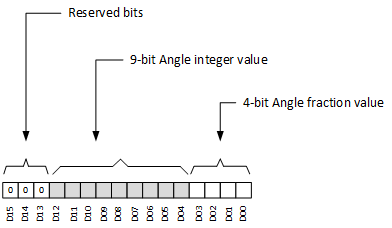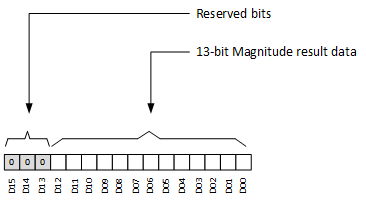JAJSJ71A June 2020 – December 2021 TMAG5170-Q1
PRODUCTION DATA
- 1 特長
- 2 アプリケーション
- 3 説明
- 4 Revision History
- 5 Pin Configuration and Functions
- 6 Specifications
-
7 Detailed Description
- 7.1 Overview
- 7.2 Functional Block Diagram
- 7.3
Feature Description
- 7.3.1 Magnetic Flux Direction
- 7.3.2 Sensor Location
- 7.3.3 Magnetic Range Selection
- 7.3.4 Update Rate Settings
- 7.3.5 ALERT Function
- 7.3.6 Threshold Count
- 7.3.7
Diagnostics
- 7.3.7.1 Memory CRC Check
- 7.3.7.2 ALERT Integrity Check
- 7.3.7.3 VCC Check
- 7.3.7.4 Internal LDO Under Voltage Check
- 7.3.7.5 Digital Core Power-on Reset Check
- 7.3.7.6 SDO Output Check
- 7.3.7.7 Communication CRC Check
- 7.3.7.8 Oscillator Integrity Check
- 7.3.7.9 Magnetic Field Threshold Check
- 7.3.7.10 Temperature Alert Check
- 7.3.7.11 Analog Front-End (AFE) Check
- 7.3.7.12 Hall Resistance and Switch Matrix Check
- 7.3.7.13 Hall Offset Check
- 7.3.7.14 ADC Check
- 7.4 Device Functional Modes
- 7.5 Programming
- 7.6 Register Map
- 8 Application and Implementation
- 9 Power Supply Recommendations
- 10Layout
- 11Device and Documentation Support
- 12Mechanical, Packaging, and Orderable Information
パッケージ・オプション
メカニカル・データ(パッケージ|ピン)
- DGK|8
サーマルパッド・メカニカル・データ
- DGK|8
発注情報
7.5.1.4 Angle and Magnitude Data Definition
The TMAG5170-Q1 calculates the angle based off the ANGLE_EN register bit settings. Figure 7-8 shows that the ANGLE_RESULT register stores the angle information in the 13-LSB bits. Bits D04-D12 store angle integer value from 0 to 360 degree. Bits D00-D03 store fractional angle value with a resolution of 1/16 degree. The 3-MSB bits are always populated as b000. The TMAG5170-Q1 CORDIC offers angle resolution of 1/4 degree. An external CORDIC may be used if higher angle resolution is required. Use Equation 7 to calculate the angle.
where
- A is the angle measured in degree.
- Di is the data bit as shown in Figure 7-8.
For example: a 354.50 degree is populated as 0001 0110 0010 1000b and a 17.25 degree is populated as 0000 0001 0001 0100b.
With DATA_TYPE ≠ 00b, the D01-D12 bits from the ANGLE_RESULT register can be accessed. In this mode, the angle fractional value is represented by 3 bit with resolution of 1/8 degree. Use Equation 8 to calculate the angle in degree.
 Figure 7-8 Angle Data Definition
Figure 7-8 Angle Data DefinitionDuring the angle calculation, use Equation 9 to calculate the resultant vector magnitude.

where
- MADCCh1, MADCCh2 are the ADC codes of the two magnetic channels selected for the angle calculation.
Figure 7-9 shows the magnitude value stored in the MAGNITUDE_RESULT register. This value should be constant during 360 degree angle measurements.
 Figure 7-9 Magnitude Result Data Definition
Figure 7-9 Magnitude Result Data DefinitionThe magnitude result can be accessed through SPI in 16-bit or 12-bit formats. In the 12-bit format, bit D01 to bit D12 are sent through the SPI.